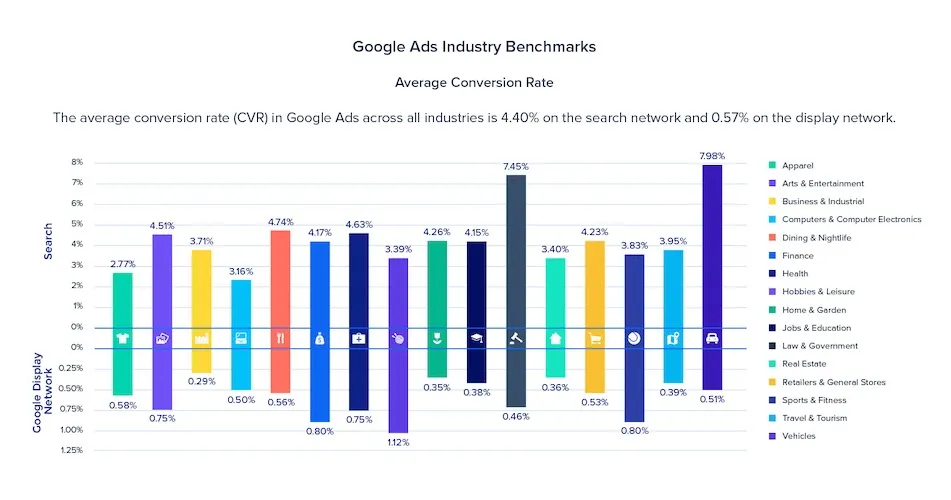read
Many people know Google divides its network into Search Ads and Display Network Ads. These two categories show up in different places and have different costs, outcomes, and audiences.
Which one is best for you?
In this article we’re going to show you four things:
A simple definition of each type of ad.
The difference between search network ads and display network ads.
When to use either search network ads or display network ads.
Why you should consider using the search and display networks at the same time. Ready to get started?
What are search and display ads?
Let’s kick things off with a quick definition for each type of ad. This will help us keep the various Google ads straight in our heads as we learn about how to use them effectively.
What Are Search Ads?
Search network ads are ads that show above and below the search results in the Google search network. Search advertising appears for the companies that win the auction for a specific search. Search engine advertising is a simple but effective way to connect to customers who are actively searching for products, brands, or services. There are three parts of a search ad:
The headline
The display URL
The description text
You can combine these three with other ad extensions to increase the information being shown to the customer. Search campaigns aim to reach the highest conversion rate possible for their target audience.
Every ad in the search network has a quality score. The quality score determines how often search ads appear, their rankings compared to other ads, and their cost per click.
Display Ads
Display network ads are ads that appear anywhere in the Google Display Network according to the targeting of display campaigns. They are “push advertising” because they can appear without a customer searching for them.
Comparing The Average Metrics For Search & Display
The Search Network and Display Network function really differently. The search network triggers ads for people who are already looking for something related to your business, products, or services. The Display Network can push ads at people in a variety of settings. These ads may or may not be closely aligned with your target audience. You can see clear differences in the conversion rates (CVR) for these Google ads and their average cost per click (CPC).
What is the Average Conversion Rate (CVR) for Search Network and Display Network Google Ads?
Search ads convert at a much higher rate than any display ad. The average CVR across all industries for search ads is 4.4%. The average for display ads is much lower, only 0.57%.

Source: instapage.com
Customers being at different points in their buying journey causes the difference in CVR. Display advertising may be shown to people who are not searching for products or solutions. Search advertising is only shown to people who are interested in a specific thing. People who are already searching for a product, service, or solution are far more likely to convert than someone checking their email who sees a display ad.
What is the Average Cost Per Click (CPC) for Search Network and Display Network Google Ads?
The average CPC for search ads is $2.41. For display ads, the average CPC is $0.59.

Source: instapage.com
The most obvious trend is how much less expensive online advertising is using a display ad compared to display advertising. Display ads are cheaper because they are less likely to convert, so advertisers are not willing to spend so much on them. Now that you know how search ads and display ads differ, how can you decide which one to use for your next PPC advertising campaign?
When to Use the Google Search Network
The search network connects advertisers to people who are searching for their products, brand, or services. You should use search ads when you have a very specific goal, audience, or budget to work towards.
1. Use Search Ads to Generate Leads and Sales
You can use specific targeting parameters with your search ads to reach your audience. A combination of positive and negative keywords will help you filter out low-quality leads from people who are ready to buy. Search networks are a great advertising platform for businesses that have a clear sale to make.
2. Use Search Ads to Set Display Ad Budgets
Display advertising is less expensive, but also converts less often. Some companies use the search volume from their search ads to determine their budget for display ads. Search ad groups with higher search volume generate a higher budget for display ads with the same ad campaign goals.
3. Use Search Ads for Consumer Services
Businesses selling services should definitely consider a search campaign. The search network excels at delivering results for service searches. For example, if you’re a plumber, run search ads that feature the words “24 Hour Service.” You’ll do great when someone’s pipes burst at 2 AM.
4. Boost Traffic with Search Ads
Text ads and a good search campaign can bring traffic and sales to your website while you wait for your diligent SEO efforts to kick in. If you’re careful with your targeting and ad spend, you can generate sales early in the life of your business without breaking the bank.
When to Use Google Display Network Ads
Display ads are brilliant for boosting brand awareness. In fact, this is their most common use. There are a few more ways to get the most out of a display campaign, though.
1. Use Display Ads for Building Awareness
Companies are building brand awareness with display ads by putting their business in front of people who may know nothing about them. Image ads in their email inbox, video ads on YouTube, or banner ads on related websites all work together to increase your brand awareness.
2. Use Display Ads for Remarketing
A clever use of display ads is to re-market specific products to customers who have visited your site or viewed your products. With the right targeting options, you can show relevant ads to people who may be making up their mind. When used this way, display ads convert almost as effectively as search ads.
3. Use Display Ads for Visual Products
A picture is worth 1000 words. This maxim is definitely true for advertising. Display ads work best for products that have a visual appeal. A restaurant, for example, will do better to show people pictures of delicious food instead of merely telling them about it.
4. Use Display Ads Strategically to Lower Cost Per Lead
Display ads can be used to find more leads at the top of the sales funnel. Reaching out to potential customers with a display ad along with an educational offer can generate more high-quality leads. You can examine your digital marketing strategy to find places to position a display ad to generate more qualified leads.
A Combination of Search AND Display PPC Strategies
You aren’t limited to one form of PPC ads. The most brilliant digital marketing strategies combine display ads and search ads. Here are two ways to get better results by using both search and display ads.
Run Separate Campaigns and Track Your Metrics
Separate campaigns make tracking progress and results much simpler. Once your PPC efforts begin to pay off, you can see which internet users to target with different ad formats.
Measure Display Ad Performance with Google Trends
Display ads should increase brand awareness. So, launch a display campaign and then monitor Google trends for keywords such as your brand name. When the needle starts to move, it may be the right time to launch paid search counterparts for your display ads.
Conclusion
Choosing the right advertising platform and running network specific campaigns (search vs display) are cornerstones of successful advertising. Now that you know more about search vs display ads, you’re ready to pick one for your next campaign. If you want help, Optimum Click has years of experience helping customers get fantastic advertising results.


![AI Advertising in 2025: Real ROI vs Expensive Hype [Guide]](/_ipx/f_webp/img/blog/blog-ai-in-the-advertising-space.jpg)
